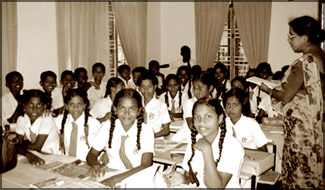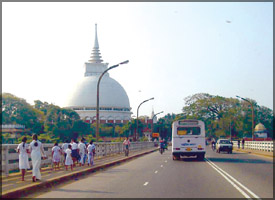
Regulating English medium education
Most of your schools must be providing you with the facility to study
in the English medium, if you prefer to do so.
Since English medium education was re-introduced a few years ago, it
has been attracting a lot of bouquets and brickbats; the latter mostly
due to the lack of
 competent and experienced teachers to conduct
teaching in English. competent and experienced teachers to conduct
teaching in English.
Now the Ministry of Education has taken initiatives to regulate the
English education system in government schools; the project aims to
upgrade the standard of English medium education so that students are up
to date with modern educational trends in the world.
This project has seen the Ministry conducting a training programme
for 450 teachers who are capable of teaching all subjects in the English
medium. There are believed to be around 450 government schools where,
from Grades Six to Eleven, all subjects are taught in English.
The National Education Policy in Sri Lanka declares that primary
education should definitely be carried out in the national languages.
Therefore, primary education is provided in Sinhala or Tamil, while
English medium education is available from Grade Six.The Ministry is
also planning to increase the number of schools which are capable of
conducting English medium classes.
The students’ eagerness to learn in English and the teachers’
availability and capability to teach all subjects in English will be
considered by the Ministry when selecting schools for this project.
The Education Ministry has also taken steps to increase the number of
schools which can conduct Advanced Level classes in English. The
Ministry has already selected 50 schools in this category and is
training teachers.
Designing greeting cards, his forte
by Ananda Kannangara
Fourteen-year-old Ishara Shehan Premaratne, a student of Gurukula
Vidyalaya, Kelaniya, was recently honoured by his school principal and
staff for his effort to produce colourful Vesak and Poson greeting
cards.
|

Ishara Shehan Premaratne
Pic: Priyantha Hettige |
Shehan started his creative career at the age of seven, by presenting
pictures for art exhibitions and competitions conducted by his school,
Gurukula Vidyalaya.
He also made greeting cards for local and foreign organisations. He
first won an award from the then Minister of Fisheries and Aquatic
Resources and present President Mahinda Rajapaksa for his painting
titled ‘A tomorrow for our coral reefs’. It was designed for a
competition conducted by the World Conservation Union-Sri Lanka.
He was also a winner at the State Children’s Art Festivals, conducted
by the Ministry of Cultural Affairs in 2007 and 2008.
He also won the first prize of the ‘Pansilu Nethkam’ art exhibition,
conducted by his school at the Colombo Art Gallery in 2006.
Among the other prizes won by Shehan are those for World Environment
Day, conducted by the Coastal Resources Management in Sri Lanka in 2005
and for Elimination of dengue menace, conducted by the Gampaha Health
Service Division in 2006.
“Making greeting cards for religious and other festivals is my main
hobby; during my leisure, I draw sceneries as well as portraits of
important personalities,” he said. Shehan also makes ornaments from
paper pulp.
He said his Dhamma School teacher Ven. Pore Dammaratne Thera and
school Principal Anil Abegunawardane had helped him immensely to develop
his talents.
Shehan also said he was grateful to his parents Lasantha and
Pushpakanthi Premaratne and his grandfather Lionel Premaratne for the
support and encouragement he had been given.
27 new sites for World Heritage List
|

Baha’i Holy Places in Haifa |
|

Chief Roi Mata’s Domain in Vanuatu. |
The World Heritage Committee finished inscribing new sites on
UNESCO’s World Heritage List with the addition of 27 cultural and
natural sites.
During the session, the 21-member committee added two new sites - the
Baha’i Holy Places in Haifa and Western Galilee (Israel) and Chief Roi
Mata’s Domain in Vanuatu - to the heritage list.
One extension was also decided by the Committee, which inscribed the
Historic Centres of Berat and Gjirokastra (Albania). This represents the
addition of the city centre of Berat to that of Gjirokastra, which was
inscribed in 2005.
The Baha’i Holy Places in Haifa and Western Galilee are inscribed for
the testimony they provide to the Baha’i’s strong tradition of
pilgrimage and for their profound meaning for the faith. The property
numbers 26 buildings, monuments and sites at 11 locations in Acre and
Haifa, associated with the founders of the faith.
Chief Roi Mata’s Domain is the first site to be inscribed in Vanuatu.
It consists of three early 17th Century AD sites on the islands of Efate,
Lelepa and Artok associated with the life and death of the last
paramount chief, or Roi Mata, of what is now Central Vanuatu.
The latest addition bring the number of this year’s new world
heritage sites to 27. The World Heritage Committee, which has so far
examined a total of 43 cultural and natural sites, approved four and 21
new heritage sites respectively during the latest session.
Among them are Tulou, the unique residential architecture of Fujian
Province, and Mount Sanqingshan National Park in Jiangxi Province in
China.
As of now, the UNESCO has 878 properties of “outstanding universal
value” on its World Heritage List. The 32nd session of the World
Heritage Committee opened on July 3 in Quebec City and lasted until July
10.
– Xinhua
Upgrading Kalutara city
 Salutary is a bustling township with all modern facilities despite it
being one of the sacred areas in our country. Salutary is a bustling township with all modern facilities despite it
being one of the sacred areas in our country.
There are plans for accelerated development of the city utilising the
latest technologies available in the market, so that it can be brought
on par with the Colombo city.
Under the accelerated Kalutara development project, which is expected
to cost a total of Rs. 4,000 million, the sacred area will be developed
alongside residential apartments, a shopping complex, courts complex,
police station, bus halt, hotel, hospital complex and playground.
Upon completion of this development project, the historical Kalutara
city is expected to be converted into one of the most beautiful cities
in the region.
Famous murals to get face-lift
The Gothami Vihara in Colombo is famous for its three-dimensional
Buddhist murals. These murals have been a subject of study and comment
for the GCE Advanced Level examination for many years. The well-known
site, with a history spanning over 70 years, is now to be rehabilitated
under a conservation programme launched by the Tourism Ministry.
Funds worth Rs. 1.5 million have already been allocated by the
Ministry towards the first phase of this project which is estimated to
cost a total of Rs. 7 million.
The first stage would involve the repainting of the murals; veteran
artist Ananda Colombage has been contracted to carry out this part of
the project. A booklet providing information on the temple and murals
has been planned too, and is expected to greatly benefit students who
study in the relevant streams.
The site is also expected to attract more visitors, both local and
foreign, after these projects are carried out. |
